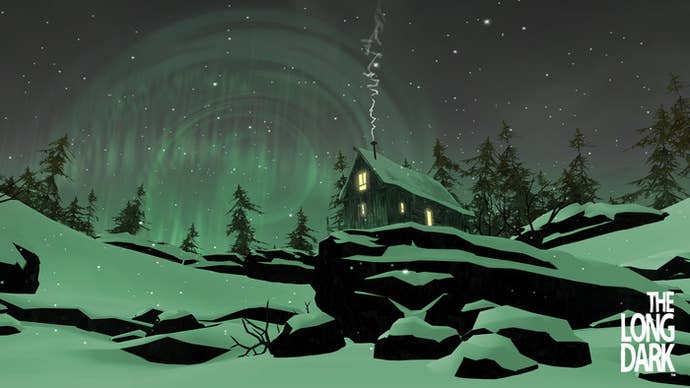2014 Recap: The Best Trends in Gaming
We've covered the worst trends in gaming. Here are some of the best.
This article first appeared on USgamer, a partner publication of VG247. Some content, such as this article, has been migrated to VG247 for posterity after USgamer's closure - but it has not been edited or further vetted by the VG247 team.
There has been a lot of doom and gloom this year, but it's not all bad. In some ways, the arrow is pointing up, and there are a few trends that point toward a vintage year for games in 2015. Here are a few of our favorites.
Jaz Rignall, Editor-at-Large
My best trend of the year has, on occasion, also been responsible for one of the worst. On the positive side, the rise of the open world game is delivering some really interesting concepts that are pushing the boundaries of games design. On the negative side, these exceptionally complex titles can sometimes be fraught with game-breaking issues that can render them almost unplayable at launch. That's a trend I really hope we don't see repeated in 2015.
Still, looking at the positive side, when they work, open world titles offer more interesting and complex gameplay than any other genre out there. I just love the way they give you the freedom to tackle things the way you want to. Sure, each of them usually has a storyline that you have to follow, but they also have side objectives and activities that essentially break up that narrative. Sometimes, like in the case of Watch Dogs, there are missions to do in order, but you're free to tackle them in different ways, and experiment with different methods to beat them. This more improvisational gaming further enhances a feeling of freedom, since it gives the impression that your plan is the one that worked, rather than you having to figure out the plan the game designer set for you to follow.
Then there's the multiplayer aspect too. I'm a little less interested in this for the most part, but nevertheless, the combination of an open world game and multiplayer can give rise to some really insane stuff - such as the kind of madness that Grand Theft Auto V is famous for.
But for me, it's Shadow of Mordor that represents the best of the open world trend in 2014. It has a narrative, but the player is given almost complete freedom to tackle things in whichever way they see fit. This concept of being your own hero and making your own adventure is really exciting to me. That's a trend I'm hoping we'll see more of next year - and it would be doubly great if a game could combine adventuring freedom with the kind of player customization we've seen in Assassin's Creed Unity and Sunset Overdrive.
I think games like this will play an increasingly important part of pushing games design forward, and I can't wait to see what's next. As long as it's properly tested beforehand, of course.

Jeremy Parish, Editor-in-Chief
Even though it makes a certain category of people really angry, I've been incredibly happy to see more and more mid-tier console publishers move to digital distribution as a platform for games that couldn't survive at American retail. Until this year, DD on consoles was basically for indie games, remakes, or terrible shovelware. In 2014, however, we really saw a huge uptick in the variety of games being distributed via PSN/eShop/XBLA.
When I look back at the games I've played and reviewed in 2014, many of them were DD titles that wouldn't have made their way to the U.S. in previous years, because the need to have a physical release would have been unavoidable... and, resultantly, too expensive. Like it or not, the U.S. is a vast country (the third largest in the world, you know), so while its large and relatively wealthy population makes it a desirable market, the cost of making sure physical content is distributed across the nation has always been a challenge for the games industry. That's a big part of why games magazines thrive in Japan and the UK but not here, and I suspect that's also a big part of why Americans have had such trouble finding Amiibos compared to their Japanese and British counterparts. And that reality has been affecting games in recent years, too.
Mainly, I'm thinking of import releases from Japan. Games that have become incredibly niche within the larger context of the industry, but which still have fans. For example, Natsume has wanted to localize Umihara Kawase games for the better part of a decade, and they finally found a way to make it happen with Yumi's Odd Odyssey for 3DS: What was a dual retail and digital release in Japan came here as digital-only, and for the first time American gamers could experience the pleasures (and pain) of this classic platformer franchise.
Big publishers like Capcom got in on the action, too. Sure, Strider is the kind of game that DD was originally born to provide us, but I was heartened to see the Ace Attorney series make its way over here again. Capcom had practically given up on the franchise at the end of the DS era, but making the jump from retail to digital in the U.S. made localizations possible again. And there have been even bigger successes, too; Xseed took a chance on Senran Kagura Burst for 3DS and created enough of a fan base that they've been able to justify localizing its sequels — Shinovi Versus for Vita even enjoyed a physical release. Whatever you may think of Senran Kagura's content and themes, the fact is that digital distribution brought a small but enthusiastic fanbase a game they wanted, and Xseed reaped the rewards.
Going forward, I'd really like to see more publishers look toward DD as a means of localizing material that may not play in the Peoria Walmart (whether due to content or simply being too granular in terms of popular appeal). I know some people dearly love their physical copies, and console makers have a long way to go before players can feel comfortable committing to digital (especially Nintendo, whose content and rights management options are abysmal), but given the choice between not having a physical copy of the game and not having the game at all, it seems like a pretty easy decision to me.
And, the move away from all-retail on consoles also means a return to broader themes, more varied content, and hopefully greater diversity and representation in games. Bald White Guy With A Gun may be the only face who sells at Gamestop counters, but this year has proven that there's a large and vocal audience of not-bald-white-guys clamoring to see more characters like themselves in games, and DD may be the Trojan horse to get them past gaming's gatekeepers. Wouldn't it be wonderfully bizarre if Senran Kagura ended up being the harbinger of better representation of women in games? Let's get weird, 2015.

Mike Williams, Associate Editor
Hey, mid-range developers! It looked like you might be in some dire straits there for awhile, but things have worked out. There's been a general constriction in the industry. On the top-end, only the mega-publishers seem to be able to play in the large-budgets AAA space. In the middle, major publishers are less likely to go with a non-internal studio for their titles. On the indie side, distribution platforms like Steam and the App Store are getting horribly crowded; if you're not already a name, it's hard to stand out. The gaming industry isn't the only one dealing with this problem, but I don't write about the film industry.
From what I've seen though, the mid-tier developer isn't going away. Yes, the field is very, very difficult, but there's some success to be found. Alternate funding options options like Kickstarter and Patreon have popped up to get you up-and-running. If you have a minimum viable product, Steam Early Access is also another option on the table. And distribution has never been easier, to the point that it might actually be too easy (see: the glut of releases).
All this means we're seeing mid-range developers like Telltale Games (Games of Thrones, Tales from the Borderlands, Minecraft: Story Mode), Double Fine (Broken Age, Massive Chalice), Obsidian Entertainment (Pillars of Eternity), Slightly Mad Studios (Project CARS), Larian Studios (Divinity: Original Sin), and inXile Entertainment (Wasteland 2, Torment: Tides of Numenera) throwing out new titles. We're seeing rising stars and smaller favorites like Coffee Stain Studios, Chucklefish, Yacht Club Games, Supergiant Games, Re-Logic, Mode 7, Dejobaan Games, and Ronimo Games creating some excellent titles.
Games like Wasteland 2, Elite Dangerous, Shadowrun Returns, Kentucky Route Zero, Papers Please, The Banner Saga, Dreamfall Chapters, The Long Dark, Never Alone, Endless Legend, Hatoful Boyfriend, and Reprisal Universe may not have flown a decade ago, but you can pick them up now. In fact, we're getting to the point where you can pick many of them up on home consoles, which would've been unheard of years ago. The depth of gaming available to us is nothing short of awe-inspiring, especially when you consider how quickly different trends converged to make it happen.
Yes, the top-end of game industry is still consolidating, with thousands working on fewer projects per year. Yes, if you're just starting out as a developer, there's a lot of pain you have to wade through just to be noticed. Despite all that, the middle is growing and thriving. It's something I'm glad to see happen and it really came to a head in 2014.

Kat Bailey, Senior Editor
I love that over the past couple years well-organized developers have been able to break the shackles of the publisher system and make the games that they really want to make.
I say this having just spent a week completely immersed in Elite: Dangerous, which is both completely insane and completely amazing. It really is a game determined to do things its own way, and I admire the vision of the Frontier Developments even as I lament the steep learning curve and the relative lack of directed story content. This is not a game that could have been made even a few years ago, and I feel like the medium is better for having it.
The same goes for other high-quality indies such as Divinity: Original Sin, Shovel Knight, and Wasteland 2, all of which were built by small but dedicated teams of veteran game developers with a genuine love and passion for what they were creating. If these games prove anything, it's that the lowest common denominator need not always win out. In the age of crowd-funding and social media, it's possible for even the most challenging material to have its day in the sun.
The flipside of crowd-funding, of course, is that some projects are a little too ambitious for their own good. Yogventures is a case study of a Kickstarter-funded game going horribly wrong, with the other pitfalls of crowd-funding being well-documented. It's enough that there has been a bit of a backlash against Kickstarter over the past year as gamers have become more discerning about which projects to fund.
In the right hands, though, crowd-funding is a valuable tool for indie developers. In that regard, I consider it a net positive. With Pillars of Eternity and many more intriguing indies set to launch in 2015, I can't wait to see what else is on tap thanks to crowd-funding.

Bob Mackey, Senior Writer
When people ask me what kind of games I like to play, it's always impossible for me to come up with a personally satisfying answer. Sure, I love RPGs, but not exclusively, and a lot of my favorite games tend to defy classification. (What would you call Katamari Damacy?) Plus, you can't just whip out a term like "visual novel" and expect people to know what you mean unless they're supplied with a boring preamble.
When I take a look at my favorite games from 2014, I'm absolutely stunned by the sheer amount of diversity on display compared to, say, what my top picks would be ten years ago. Last year, Monster Hunter 3 Ultimate and Gone Home had the honor of being my favorite games, which goes to show just how wonderfully diverse this medium can be. And 2014 is no different: My top three games this year are Dark Souls 2, Danganronpa, and Mario Kart 8, three creations that have as little to do with each other as scientifically possible. Yes, my tastes could just be expanding as I grow older, but it's hard to deny just how many different types of experiences games can provide in these modern times. And this increase in diversity has been one of my favorite trends of 2014.
Yes, I still stick to my RPGs—the sheer amount of time I poured into Dark Souls 2 stands as proof—but I've really enjoyed the variety of strange and new gaming experience I've had this year. I dug into Inazuma Eleven's sports/RPG hybrid, succumbed to the elements multiple times in The Long Dark, soaked up the beautiful scenery and haunting mysteries of The Vanishing of Ethan Carter, cooked up delicious dishes in Fantasy Life, fell victim to the hellish first-person whimsy of Lovely Planet, and busted some grooves in the rhythm-based roguelike, Crypt of the Necrodancer. And that's just what I can remember offhand!
This may seem like an extremely personal choice for this year's best trends, but I find that as massive publishers continue dump incredible amounts of money into established formulas, it's the outliers that manage to catch my attention. And 2014 has definitely continued this trend, despite outcries from those who feel alienated that video games might not be specifically made for them anymore. But, regardless of who you are, you're bound to find a game that appeals to you—and, as someone who wants this medium to last far in the future, that's incredibly good news for all of us.





_ddwYK80.png?width=291&height=164&fit=crop&quality=80&format=jpg&auto=webp)


